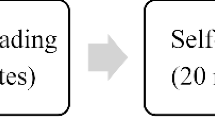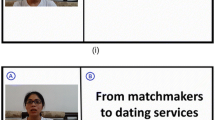Abstract
In this investigation, one study examined the perceptions and motivation of 55 deaf/hard-of-hearing (DHH) high school students who used the C-Print speech-to-text service as an accommodation in one mainstream course and interpreting and note taking in a second mainstream course. A second study examined the perceptions and motivation of 88 DHH college students who used each service in a different course. Students in the two studies completed a survey that asked separate sets of questions for the speech-to-text and for the interpreting/note taking supported courses. Results indicated that students rated the printed or electronic file text, saved for the purpose of after class study as part of the speech-to-text service, as more helpful than notes from a note taker.
Similar content being viewed by others
References
Aylesworth, S. (2006). 2006 survey of postsecondary speech-to-text services salary and program demographics. St. Paul: Midwest Center for Postsecondary Outreach, St. Paul Technical College Retrieved from http://www.mcpo.org/speechtotext_survey.asp.
Billes, P., Buchoski, D., Kolvitz, M., Sanderson, G., & Walter, G. (2003). Postsecondary education programs network (PEPNet): needs assessment-2002. Rochester: National Techical Institute for the Deaf, Northeast Technical Assistance Center.
Brophy J. (2004). Motivating students to learn (2nd edn.). Mahwah, N.J.: Lawrence Earlbaum Associates, Publishers.
Cawthon, S., Leppo, R., & the pepnet2 Research and Evidence Synthesis Team. (2013). Accommodations quality for students who are d/deaf or hard of hearing. American Annals of the Deaf, 158(4), 438–452.
Conley, D. (2007). The challenge of college readiness. Educational Leadership, 64(7), 23–29.
Cooper, H., & Valentine, J. (2001). Using research to answer practical questions about homework. Educational Psychologist, 36(3), 143–153.
Cooper, H., Lindsay, J., Nye, B., & Greathouse, S. (1998). Relationships among attitudes about homework, amount of homework assigned and completed, and student achievement. Journal of Educational Psychology, 90(1), 70–83.
Cuculick, J. A., & Kelly, R. R. (2003). Relating deaf students’ reading and language entry scores at college entry to their degree completion rates. American Annals of the Deaf, 148(4), 279–286.
de Jong, T. (2010). Cognitive load theory, educational research, and instructional design: Some food for thought. Instructional Science, 38, 105–134. doi:10.10075/s11251–009–9110-0.
Dettmers, S., Trautwein, U., Lüdke, O., Kunter, M., & Baumert, J. (2010). Homework works if homework quality is high; using multilevel modeling to predict the development of achievement in mathematics. Journal of Educational Psychology, 102(2), 467–482.
Elliot, L. B., Stinson, M. S., McKee, B. G., Everhart, V. S., & Francis, P. J. (2001). College students’ perceptions of the C-print speech-to-text transcription system. Journal of Deaf Studies and Deaf Education, 6(4), 285–298.
Elliot, L., Foster, S., & Stinson, M. (2002). Student study habits using notes from a speech-to-text support service. Exceptional Children, 69(1), 25–40.
Feldman, E., Kim, J. S., & Elliott, S. (2011). The effects of accommodations on adolescents’ self-efficacy and test performance. The Journal of Special Education, 45(2), 77–88.
Furui, S., Deng, L., Gales, M., Ney, H., & Tokuda, K. (2012). Fundamental technologies in modern speech recognition. IEEE Signal Processing Magazine, 29(6), 16–17.
Hastings, D., Brecklin, K., Cermak, S., Reynolds, R., Rosen, H., & Wilson, J. (1997). Note taking for deaf and hard of hearing students: A report of the National Task Force on Quality of Services in the Postsecondary Education of Deaf and Hard of Hearing Students. Rochester: Northeast Technical Assistance Center, Rochester Institute of Technology. (ERIC Document Reproduction Service No. ED 437 777).
Katz, I., Eilot, K., & Nevo, N. (2013). “I’ll do it later”: type of motivation, self-efficacy and homework procrastination. Motivation and Emotion, 38, 111–119.
Lang, H. (2002). Higher education priorities for deaf students: research priorities in the new millennium. Journal of Deaf Studies and Deaf Education, 7(4), 267–280.
Marschark, M., Leigh, G., Sapere, P., Burnham, D., Convertino, C., Stinson, M., Knoors, H., Vervloed, M. P. J., Noble, W., Madden, M., Jackson, L., & Grebennikov, L. (2006). Benefits of sign language interpreting and text alternatives for deaf students’ classroom learning. Journal of Deaf Studies and Deaf Education, 11(4), 421–437.
Mayer, R. E., & Moreno, R. (1998). A split-attention effect in multimedia learning: evidence for dual processing systems in working memory. Journal of Educational Psychology, 90, 312–320.
National Technical Institute for the Deaf (NTID) (2013). C-Print training. Retrieved from https://www.rit.edu/ntid/cprint/training.
Office of Special Education Programs (OSEP). (2014) U.S. department of education, office of special education programs, Individuals with Disabilities Education Act (IDEA) data base. Retrieved from http://nces.ed.gov/programs/digest/d14/tables/dt14_204.60.asp.
Pelz, J., Marschark, M., & Convertino, C. (2008). Visual gaze as a marker of deaf students’ attention during mediated instruction. In M. Marschark & P. Hauser (Eds.), Deaf cognition: foundations and outcomes (pp. 264–285). New York: Oxford University Press.
Qi, S., & Mitchell, R. E. (2012). Large-scale academic achievement testing of deaf and hard-of-hearing students: past, present, and future. Journal of Deaf Studies and Deaf Education, 17(1), 1–18.
Reed, S., Antia, S., & Kreimeyer, K. (2008). Academic status of deaf and hard-of-hearing students in public schools: student, home, and service facilitators and detractors. Journal of Deaf Studies and Deaf Education, 13, 485–502. doi:10.1093/deafed/enn006.
Stegers-Jager, K., Schotanus, J., & Themmen, A. (2012). Motivation, learning strategies, participation, and medical school performance. Medical Education, 46, 678–688.
Stinson, M. S. (2010). Current and future technologies in the education of deaf students. In M. Marschark & P. Spencer (Eds.), Oxford handbook of deaf studies, language, and education (pp. 93–110). New York: Oxford University Press.
Stinson, M., & Elliot, L. (2015). Analyzing the use of C-print mobile technology in STEM lab settings across multiple postsecondary sites. NTID, Rochester: Final report to NSF.
Stinson, M., & Whitmire, K. (2000). Adolescents who are deaf or hard of hearing: a social psychological perspective on communication and educational placement. Topics in Language Disorders, 20, 58–73.
Stinson, M. S., Stuckless, E. R., Henderson, J., & Miller, L. (1988). Perceptions of hearing impaired college students toward real-time speech-to-print: RTGD and other support services. Volta Review, 90, 336–348.
Stinson, M. S., Elliot, L. B., & Francis, P. (2008). The C-print system: using captions to support classroom communication access and learning by deaf and hard of hearing students. In C. Schlenker-Schulte & A. Weber (Eds.), Barrieren überwinden—Teilhabe ist möglich! Villingen-Schwenningen (pp. 102–122). Villingen-Schwenningen: Neckar-Verlag.
Stinson, M. S., Elliot, L., Kelly, R. R., & Liu, Y. (2009). Deaf and hard of hearing students memory of lectures with speech-to-text and interpreting/note taking services. Journal of Special Education., 43(1), 52–64.
Stinson, M., Francis, P., & Elliot, L. (2013, July 10). Mobile speech-to-text captioning services: an accommodation in STEM laboratory courses. Paper presented at the conference of the Association of Higher Education and Disability, Baltimore, MD.
Stinson, M., Elliot, L., & Easton, D. (2014). Deaf/hard of hearing and other postsecondary learners’ retention of STEM content with tablet computer based notes. Journal of Deaf Studies and Deaf Education, 19(2), 251–269.
Venkatesh, V., Morris, M., Davis, G., & Davis, F. (2003). User acceptance of information technology: toward a unified view. MIS Quarterly, 27(3), 425–478.
Venkatesh, V., Thong, J., & Xu, X. (2012). Consumer acceptance and use of information technology: extending the unified theory of acceptance and use of technology. MIS Quarterly, 36(1), 157–178.
Wagner, M., Newman, L., Cameto, R., & Levine, P. (2006). The academic achievement and functional performance of youth with disabilities. A report from the National Longitudinal Transition Study-2 (NLTS2) (NCSER 2006–3000). Menlo Park, CA: SRI International.
Walter, G. G. (2010), Deaf and hard-of-hearing students in transition: Demographics with an emphasis on STEM education. National Technical Institute for the deaf, Rochester Retrieved from www.rit.edu/ntid/cat/enrichment/datasurveys.
Woodcock, R. W., McGrew, K. S., & Mather, N. (2001). Woodcock-Johnson tests of academic achievement-research edition. Itasca, IL: Riverside Publishing.
Acknowledgments
We thank Susan Stinson for data analysis and the participating colleges and school districts for their collaboration.
This research was supported in part by grant H180U960004 from the U.S. Department of Education, Office of Special Education Programs.
Author information
Authors and Affiliations
Corresponding author
Ethics declarations
Ethical Approval
All procedures performed in this study were in accordance with the ethical standards of the institutional and/or national research committee and with the 1964 Helsinki declaration and its later amendments or comparable ethical standards.
Informed Consent
Informed consent was obtained from all individual participants in the study.
Conflicts of Interest
There are no conflicts of interest for the authors.
Appendix 1
Appendix 1
Questions Specific to Course with Speech-to-Text (C-Print) Support
TO THE STUDENT:
This questionnaire is not part of your school work. It will not be graded. If you decide you do not want to finish the questionnaire, you can stop at any time. We need your honest answers. Please read each question carefully. Thank you for your help.

Questions Specific to Course with Interpreting/Note taking Support
NOTICE! THESE QUESTIONS ARE ABOUT A DIFFERENT COURSE.

Questions Repeated for Each Course

Rights and permissions
About this article
Cite this article
Stinson, M.S., Elliot, L.B. & Kelly, R.R. Deaf and Hard-Of-Hearing High School and College Students’ Perceptions of Speech-To-Text and Interpreting/Note Taking Services and Motivation. J Dev Phys Disabil 29, 131–152 (2017). https://doi.org/10.1007/s10882-017-9534-4
Published:
Issue Date:
DOI: https://doi.org/10.1007/s10882-017-9534-4




